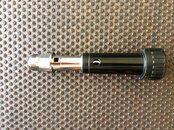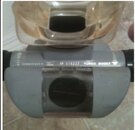You are using an out of date browser. It may not display this or other websites correctly.
You should upgrade or use an alternative browser.
You should upgrade or use an alternative browser.
Sea Hornet Air Commando Regulators
- Thread starter brianf482
- Start date
Please register or login
Welcome to ScubaBoard, the world's largest scuba diving community. Registration is not required to read the forums, but we encourage you to join. Joining has its benefits and enables you to participate in the discussions.
Benefits of registering include
- Ability to post and comment on topics and discussions.
- A Free photo gallery to share your dive photos with the world.
- You can make this box go away
I'v never heard of the Air Commando.
I'v heard of a Commander, & a Command Air.
I have used their Navy Commander 2nd stage with one of their diaphragm 1st stages. Seemed to be an OK reg set.
I have no idea if they are still in business, the link to their site in my favourites no longer works. Below are some contact details I have, but no idea if they are still valid.
Sea Hornet Head Office
A division of T.D. Preece & Co. Pty Ltd.
1 Kenneth Road, Manly Vale NSW 2093, Australia
(612) 9948 0273
tdpreece@seahornet.com.au
I'v heard of a Commander, & a Command Air.
I have used their Navy Commander 2nd stage with one of their diaphragm 1st stages. Seemed to be an OK reg set.
I have no idea if they are still in business, the link to their site in my favourites no longer works. Below are some contact details I have, but no idea if they are still valid.
Sea Hornet Head Office
A division of T.D. Preece & Co. Pty Ltd.
1 Kenneth Road, Manly Vale NSW 2093, Australia
(612) 9948 0273
tdpreece@seahornet.com.au
Attachments
That might be a good choice if you live in the dry "Down Under".
I'm resurrecting this thread with some updated info that hopefully will be useful to other fans of the Australian Sea Hornet Command Air regulators and the associated MK 1, 2, 5, 7 piston and MK 6/6S diaphragm first stages.
I recently bought a couple of Command Air regs attached to a MK 5 yoke reg... they came with 3 OEM service kits AND the special tool to remove the turret swivel nut!
I'd seen these being used fairly commonly up until a few years ago, with JD Preece's sad demise Sea Hornet spares are thin on the ground now so the regs tend to get binned. A pity because they had some pretty impressive performance figures and innovative features.
For example:
- MK 1 piston first stage could deliver 1800 L/min from one port
- MK 6S diaphragm first stage could deliver 1850 L/min from one port
- Command Air second stage could deliver 1000 L/min with a sensitivity of 0.5 to 2.0 inches of water via the adjust knob at 10 BAR (145psi) Intermediate Pressure
- Commander second stage could deliver 1400 L/min with equal sensitivity... teamed with a MK 6S this was marketed as THE deep water reg, and was used by the Royal Australian Navy (RAN) clearance divers and other specialists.
Not sure why they went to the trouble of making a clear flip-up access flap for the exhaust valve, or why they spent money on Teflon coating the mainspring (now brittle with age and flaked off in the ultrasonic bath!) yet inexplicably made the demand lever in their premium line regulator from plated brass instead of stainless steel. These brass levers are soft and can get green corrosion with pitting under the contact point with the diaphragm plate after sitting for a while. Their budget line Explorer II regs DID have stainless demand levers!
Instead of using a lightweight plastic poppet carrier Sea Hornet opted for a machined plated brass design.
The Turbo control is pretty cool and really does work...
Turning this knob will vary the assistance of the venturi effect. This allows the diver to increase air flow to the maximum without increase in inhalation effort.
You can see how a port in the air barrel is opened and closed as a corresponding hole in the Turbo sleeve is rotated.
Seems JD Preece patented the idea so I will look for the number later on.
In what perhaps was the ultimate in customer focus, the MK 1 first stage was also available as a gold plated special edition
The Gold Plated MK 1 is dedicated for dive instructors with their name and qualification embossed on the body of the first stage.
Attachments
Last edited:
Unfortunately for spare parts availability Sea Hornet's... ahem... inspiration from the G250's design for the Command Air did not extend to the diaphragm 
The Command Air is a little bigger at 75mm vs 72mm for the G250, but with a much larger demand lever contact plate... accordingly the demand lever arms are spread out wider.
Both are silicon, very thin and flexible.
Command Air on the left, G250 on the right:

The Command Air is a little bigger at 75mm vs 72mm for the G250, but with a much larger demand lever contact plate... accordingly the demand lever arms are spread out wider.
Both are silicon, very thin and flexible.
Command Air on the left, G250 on the right:
Ghetto Diver
Contributor
^Good post....
I am 99.9% sure these are re-branded Pro Sub Command Air regs.
I have several of these 2nd stages, which I picked up over time for no more than $20 each. As you stated, very good breathers, I refer to these as sleeper regs.
I have the parts diagram for them I got direct from ProSub....o rings easily sourced, the lp seat is the small thin one which I punch out myself.
If anyone needs help with a kit let me know
They also made them for Parkway.
My latest one in near new condition..


ETA
Not mine, but found some crappy pics of Parkway version with different faceplate.


I am 99.9% sure these are re-branded Pro Sub Command Air regs.
I have several of these 2nd stages, which I picked up over time for no more than $20 each. As you stated, very good breathers, I refer to these as sleeper regs.
I have the parts diagram for them I got direct from ProSub....o rings easily sourced, the lp seat is the small thin one which I punch out myself.
If anyone needs help with a kit let me know
They also made them for Parkway.
My latest one in near new condition..
ETA
Not mine, but found some crappy pics of Parkway version with different faceplate.
Attachments
Last edited:
Thanks Ghetto diver, very interesting re the ProSub angle... they do seem identical, but wondering if it is a 'chicken or egg' situation?
Did the Command Air regulator Intellectual Property get sold off to ProSub when JD Preece ceased operations?
The liquidators sold the IP rights and tooling for the Sea Hornet speargun range to AB Biller in the US.
Or were they manufactured by ProSub on contract to JD Preece?
I was always under the impression Sea Hornet was designed and manufactured in Sydney, Australia... so I'm tending towards the former explanation.
Interesting also to see the progression of patent markings... both of mine are just stamped Patented.
However your two are stamped Patent Pending 017971 and 018227, a quick search on Google Patents comes up blank... and the numbers are both too short to be an Australian Design Registration number which is 9 digits.
Yes, please!
Be very keen to see a schematic and/or overhaul guide, plus any info you may have on where to source first and second stage service kits or the size specifications for the o-rings required.
Did the Command Air regulator Intellectual Property get sold off to ProSub when JD Preece ceased operations?
The liquidators sold the IP rights and tooling for the Sea Hornet speargun range to AB Biller in the US.
Or were they manufactured by ProSub on contract to JD Preece?
I was always under the impression Sea Hornet was designed and manufactured in Sydney, Australia... so I'm tending towards the former explanation.
Interesting also to see the progression of patent markings... both of mine are just stamped Patented.
However your two are stamped Patent Pending 017971 and 018227, a quick search on Google Patents comes up blank... and the numbers are both too short to be an Australian Design Registration number which is 9 digits.
Yes, please!
Be very keen to see a schematic and/or overhaul guide, plus any info you may have on where to source first and second stage service kits or the size specifications for the o-rings required.
Ghetto Diver
Contributor
No idea about who was first. Prosub did use Tabata's (tr30 I believe) firsts amongst others early on, then eventually they made their own.
I mate mine to Sherwoods set at 140-145.
I don't have service manual, just schematic that details parts out, including orings. I will send it to you. I don't know the Trident equivalent is, but the lp seat I make is from epdm .060" x .200 dia.
I mate mine to Sherwoods set at 140-145.
I don't have service manual, just schematic that details parts out, including orings. I will send it to you. I don't know the Trident equivalent is, but the lp seat I make is from epdm .060" x .200 dia.
Thanks, much appreciated!
The Sea Hornet brochures all detail Command Air performance specifications at a line pressure of 10 BAR or 145 psi so you are spot on.
Merry Christmas
The Sea Hornet brochures all detail Command Air performance specifications at a line pressure of 10 BAR or 145 psi so you are spot on.
Merry Christmas
For general info, the o-rings required to service a Sea Hornet/ProSub Command Air second stage regulator are:
Thanks again to Ghetto Diver
-010 (2 required)
-013
-015
-016
All 70 Duro-013
-015
-016
Thanks again to Ghetto Diver

Similar threads
- Replies
- 24
- Views
- 1,379
- Replies
- 8
- Views
- 781






